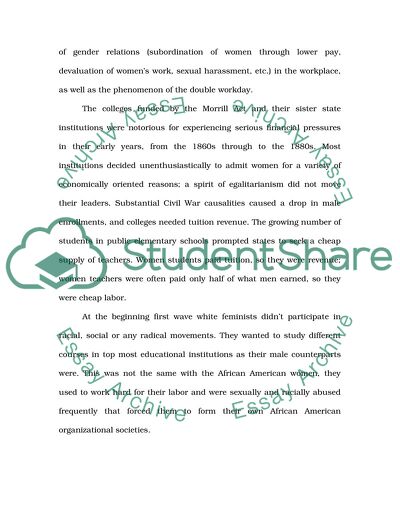
- Home
- Free Samples
- Premium Essays
- Editing Services
- Extra Tools
- Essay Writing Help
- About Us
- Studentshare
- Subjects
- Miscellaneous
- How did race influence the positions of first-wave feminists
How did race influence the positions of first-wave feminists - Essay Example

- Subject: Miscellaneous
- Type: Essay
- Level: Ph.D.
- Pages: 4 (1000 words)
- Downloads: 0
- Author: abigalelehner
Extract of sample "How did race influence the positions of first-wave feminists"
First wave feminists examined the issue of women’s oppression as imbricated with other oppressions, specifically class based oppression. Initially divided among, those who sought single-system analysis (a single explanation for the mechanisms of oppression operative in capitalism and in patriarchy) and others who developed dual-system analyses, this body of theory has been oriented toward finding the material, historical, and contextual bases for multiple oppressions (class, gender, race, sexuality, and so forth).
The gender theory proffered in these analyses has varied widely. Other socialist feminists have noted the usefulness to capitalism of the gendered division of labor in the household, volunteer work, and paid labor. Socialist feminists have examined the maintenance of gender relations (subordination of women through lower pay, devaluation of women’s work, sexual harassment, etc.) in the workplace, as well as the phenomenon of the double workday. The colleges funded by the Morrill Act and their sister state institutions were notorious for experiencing serious financial pressures in their early years, from the 1860s through to the 1880s.
Most institutions decided unenthusiastically to admit women for a variety of economically oriented reasons; a spirit of egalitarianism did not move their leaders. Substantial Civil War causalities caused a drop in male enrollments, and colleges needed tuition revenue. The growing number of students in public elementary schools prompted states to seek a cheap supply of teachers. Women students paid tuition, so they were revenue; women teachers were often paid only half of what men earned, so they were cheap labor.
At the beginning first wave white feminists didn’t participate in racial, social or any radical movements. They wanted to study different courses in top most educational institutions as their male counterparts were. This was not the same with the African American women,
...Download file to see next pages Read More
- TERMS & CONDITIONS
- PRIVACY POLICY
- COOKIES POLICY